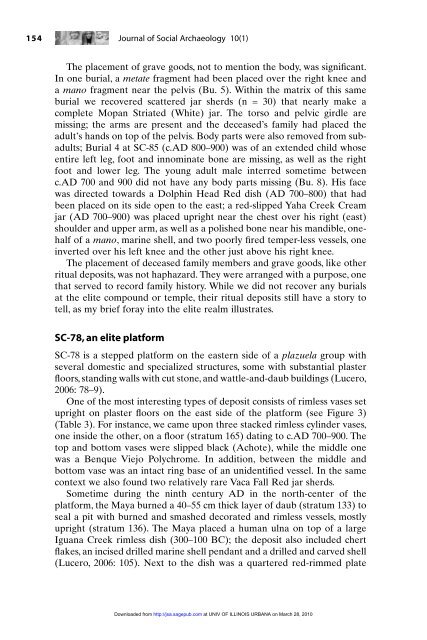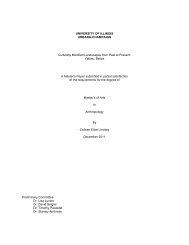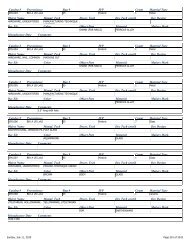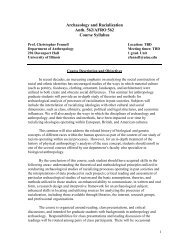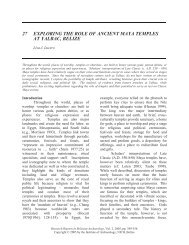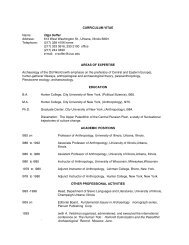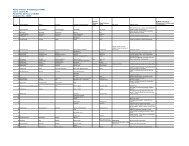Materialized Cosmology among Ancient Maya Commoners.
Materialized Cosmology among Ancient Maya Commoners.
Materialized Cosmology among Ancient Maya Commoners.
Create successful ePaper yourself
Turn your PDF publications into a flip-book with our unique Google optimized e-Paper software.
154 Journal of Social Archaeology 10(1)The placement of grave goods, not to mention the body, was significant.In one burial, a metate fragment had been placed over the right knee anda mano fragment near the pelvis (Bu. 5). Within the matrix of this sameburial we recovered scattered jar sherds (n = 30) that nearly make acomplete Mopan Striated (White) jar. The torso and pelvic girdle aremissing; the arms are present and the deceased’s family had placed theadult’s hands on top of the pelvis. Body parts were also removed from subadults;Burial 4 at SC-85 (c.AD 800–900) was of an extended child whoseentire left leg, foot and innominate bone are missing, as well as the rightfoot and lower leg. The young adult male interred sometime betweenc.AD 700 and 900 did not have any body parts missing (Bu. 8). His facewas directed towards a Dolphin Head Red dish (AD 700–800) that hadbeen placed on its side open to the east; a red-slipped Yaha Creek Creamjar (AD 700–900) was placed upright near the chest over his right (east)shoulder and upper arm, as well as a polished bone near his mandible, onehalfof a mano, marine shell, and two poorly fired temper-less vessels, oneinverted over his left knee and the other just above his right knee.The placement of deceased family members and grave goods, like otherritual deposits, was not haphazard. They were arranged with a purpose, onethat served to record family history. While we did not recover any burialsat the elite compound or temple, their ritual deposits still have a story totell, as my brief foray into the elite realm illustrates.SC-78, an elite platformSC-78 is a stepped platform on the eastern side of a plazuela group withseveral domestic and specialized structures, some with substantial plasterfloors, standing walls with cut stone, and wattle-and-daub buildings (Lucero,2006: 78–9).One of the most interesting types of deposit consists of rimless vases setupright on plaster floors on the east side of the platform (see Figure 3)(Table 3). For instance, we came upon three stacked rimless cylinder vases,one inside the other, on a floor (stratum 165) dating to c.AD 700–900. Thetop and bottom vases were slipped black (Achote), while the middle onewas a Benque Viejo Polychrome. In addition, between the middle andbottom vase was an intact ring base of an unidentified vessel. In the samecontext we also found two relatively rare Vaca Fall Red jar sherds.Sometime during the ninth century AD in the north-center of theplatform, the <strong>Maya</strong> burned a 40–55 cm thick layer of daub (stratum 133) toseal a pit with burned and smashed decorated and rimless vessels, mostlyupright (stratum 136). The <strong>Maya</strong> placed a human ulna on top of a largeIguana Creek rimless dish (300–100 BC); the deposit also included chertflakes, an incised drilled marine shell pendant and a drilled and carved shell(Lucero, 2006: 105). Next to the dish was a quartered red-rimmed plateDownloaded from http://jsa.sagepub.com at UNIV OF ILLINOIS URBANA on March 28, 2010


